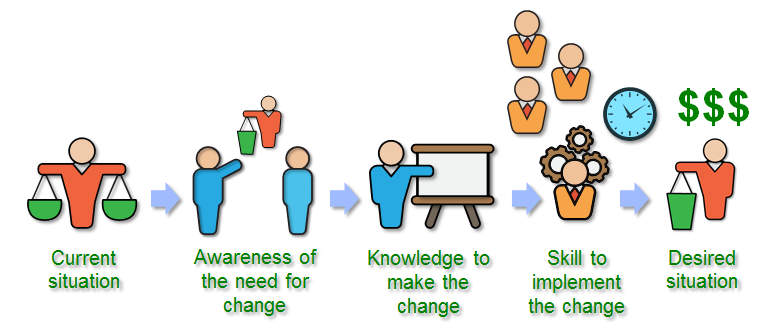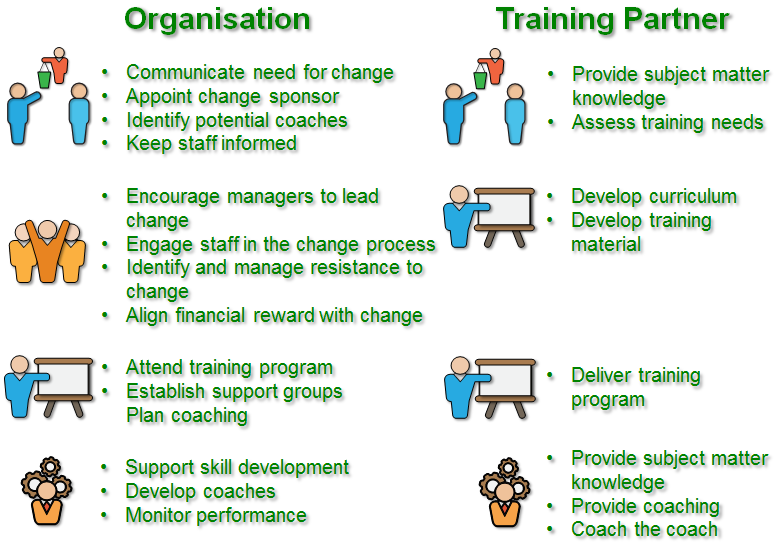Change Driven Training

When staff need to improve their skills, organisations usually think in terms of training. Often, the new skills they need are described as training needs which are then used to identify suitable training courses.
Once the ‘right’ course has been found, students are ‘processed’ through the course in batches. Each student receives a certificate, in recognition of what they have learnt and everyone pats themselves on the back, for a job well done!
So frequently, it comes as a surprise when organisations find that this ‘pipeline’ approach to training, does little to improve the skills of their staff. To understand why we have to look at what happens after the training course has finished.
When staff return to their workplace, they are often reminded that knowledge and skills are not the same thing. It’s common for staff to have difficulty applying what they have learnt on a course. Sometimes this is because the training needs weren’t well aligned with the job skills required. At other times, it might be because the training course was too theoretical, or maybe it just wasn’t taught very well and of course, sometimes staff are just not motivated to learn.
Whatever the reason, an organisation may find that their investment in training has not really improved the skills of their staff. Even when training needs are well aligned with job skills and staff attend high quality training courses, organisations sometimes find that they don’t get the skills improvement they had hopped for.
Often this is because staff are not given the opportunity after the course, to consolidate and build on the skills they have learnt.

Under pressure, it’s human nature to revert back to the tried and tested way of doing things, rather than risk failure by trying something new.
So what’s to be done?
Well one approach is to focus on the need for change, rather than staff skills. In other words, organisations should first ask themselves the question:
How can we improve by doing things differently?
Rather than asking:
What skills do our staff need?
Once we understand what needs to change, it becomes clear how staff will need to work differently and which skills they need to improve, in order to support the change. This is what I call change-driven training.

Lets take these ideas and expand them into with more detail. Change-driven training starts with the need to improve a situation. This need for improvement, is often triggered by problems or inefficiencies in the way things are currently done. It’s critical that there is an awareness of the need for change and wide spread agreement on the nature of the change. Without this awareness, and agreement, the change process won’t get started and people will simply learn to live with the current situation.
Once everyone agrees on the nature of the change, they can start thinking about training and here we need to make a clear distinction between knowledge and skills. Attending a training course ensures that staff will have the knowledge required to implement the change, but they must also be given an opportunity to develop the new skills they will need to implement the change.

Simply attending a training course is not enough, staff also need encouragement and time to practice once they return to work. They might also need support and coaching to help them successfully apply the knowledge they have gained from a training course.
Once staff have achieved an acceptable level of competency, the change will have been implemented and the organisation can start reaping the rewards that come from an improved way of working.
Sounds easy!
Unfortunately, it’s not quite as simple as it sounds. Organisations encounter many obstacles when they try to change. When staff hit a major roadblock, they often fall back to the old way of working. If there’s no one to steer them around the roadblock, there’s a danger that the need for change will soon be forgotten and the whole affair will be remembered as yet another failed experiment.
In order to keep things moving along smoothly, change must be actively managed. Change management is a structured approach to change that anticipates where problems might occur and guides staff around any obstacles that threaten to block the change.
There are many different approaches to change management. One that stands out is the ADKAR change management model developed by Prosci. One of the strengths of ADKAR is that it focuses on individual change, so it’s well suited to change-driven training. There are many articles and books available which describe ADKAR in detail. ADKAR is an acronym for the five milestones that individual staff must pass through in order to successfully implement a change.

First, staff must be aware of the need for change. Then they must develop a genuine desire to support the change.
Once they have passed through the awareness and desire milestones, they are ready to acquire the knowledge they need to change. As I have said before, knowledge and skills are not the same thing, this is why the next milestone focuses on staff developing the ability to implement the change.
Finally, the organisation will need to offer some form of reinforcement that encourages staff to sustain the change.
So this is the ADKAR change management model. As you can see, it consists of five simple milestones that individuals have to pass through in order for a change to be successfully implemented.
Not all organisations have the resources to develop in-house training programs and so many turn to off the shelf courses. If they’re lucky, they may find course content that is perfectly aligned to their needs or maybe a course provider that is willing to customise the course content. Either way, they still need to integrate the training into a managed change program.
An alternative approach, is to work with a training partner that already understands change-driven training and is able to stay with the organisation as they move through the ADKAR milestones. A training partner can begin by providing subject matter knowledge and assessing staff training needs while the organisation builds awareness of the need for change.

The training partner can develop training material while the organisation continues to build awareness and foster the desire to support the change. This can help to keep the organisation stay focused on the need for change without becoming distracted by the detail of course curricula.
Training may be delivered as instructor led training, webinars, eLearning or even as a ‘flipped’ classrooms, with staff watching videos individually followed by attending instructor led workshops that provide an opportunity to apply what they have learnt from watching the videos.
If no in house coaches are available, the training partner may offer to coach staff to help them develop their skills. Some training partners may also assist in developing in house coaches by offering a ‘coach the coach’ program.